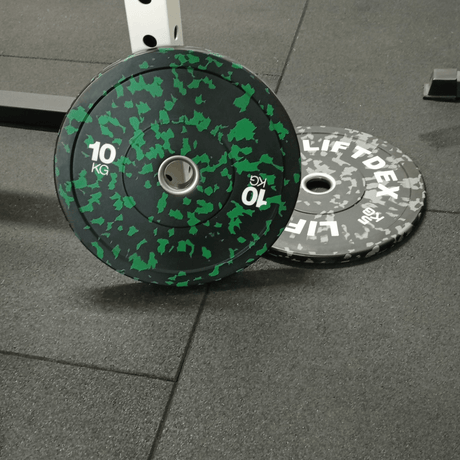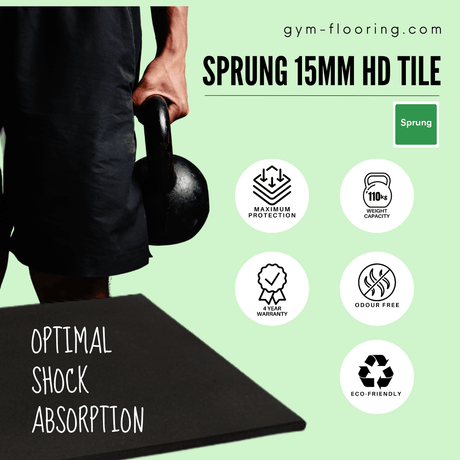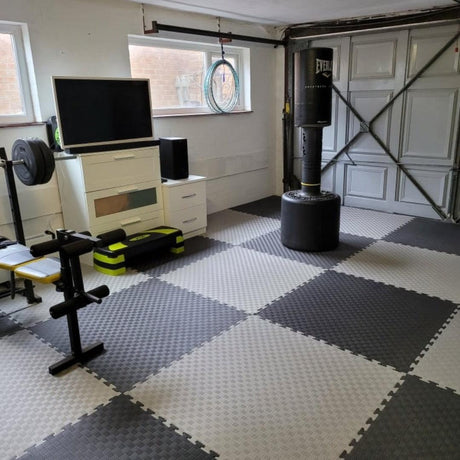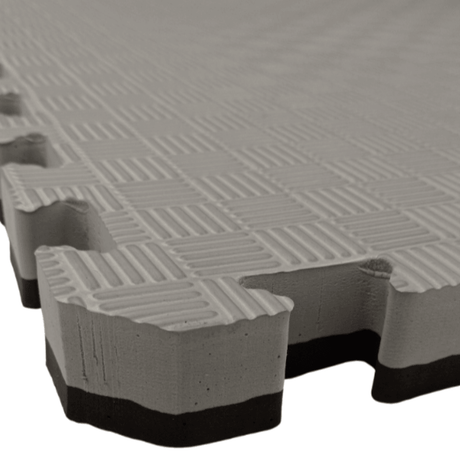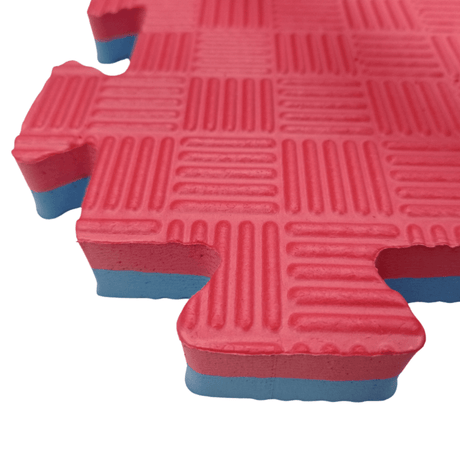When it comes to your gym setting, choosing the right flooring is a big decision. Every activity is different. Unlike a traditional gym, CrossFit training has specific requirements. It’s important to choose the best flooring for CrossFit so that it supports your workout and offers the optimum amount of protection. You want something that can handle a combination of plyometric moves and heavy barbell drops with the perfect level of shock absorption.
Whether you’re building a CrossFit box at a commercial gym or home gym, the floor needs to be able to take on everything you can throw at it. You can’t drop extremely heavy barbells on concrete; it'll simply not end well.
In this article, we'll explore the main reasons for why CrossFit flooring is important as well as break down the 3 best flooring options for CrossFit Training.
Table of Contents
Why do You Need the Right Flooring for CrossFit?
3 Best CrossFit Flooring Options
How Thick Should Your CrossFit Flooring Be?
Why do You Need the Right Flooring for CrossFit?

CrossFit combines weightlifting, cardio, and bodyweight exercise for an intense and high-performance workout. During CrossFit sessions, the floor needs to able to handle repeated movement as well as protect the body from injury. Therefore, the flooring needs a certain level of endurance and protection. When you repeatedly perform high impact exercises using heavy weights, you want to give yourself the best opportunity to carry out movements safely.
It’s common to perform movements such as deadlifts, squats, shoulder press, kettlebell swings, and burpees. When you think about your CrossFit flooring, consider what you will be doing regularly and the type of surface that will support your goals. For example, foam flooring will cushion the body from high impact exercise and plyometric moves but may not be durable enough to withstand heavy weights.
The wrong flooring could end up damaging the floor and make you more prone to injury. This is because the flooring might not have the level of traction and shock absorption for comfortable workouts that absorb intense movements and act as a buffer to the underfloor.
Athlete Insight:
"Since I started CrossFit I've realised that having the basics in place are so important to effective training. Not fancy equipment - but the fundamentals to keep training consistently"
J Murdoch, Cheltenham
Similarly, an inadequate surface with no slip-resistance or traction could result in slips and falls or an ineffectual performance due to poor grip or premature fatigue. A CrossFit floor should absorb all impact from activity and weights as well as offering slip resistance and anti-fatigue properties to ensure a safe and efficient training session where you can focus on your form, technique, and overall performance.
In summary:

3 Best CrossFit Flooring Options
CrossFit is a high impact activity that involves weights, plyometric exercise, and cardio. Due to the natural variety of CrossFit, you need to choose a flooring surface that caters for different types of exercise. Here are three of the best CrossFit flooring options:
1. Rubber Floor Tiles
By far the best option for CrossFit, rubber floor tiles come in a range of thicknesses which greatly determine the suitability of use. For example, the lower end of the scale (11mm, 15mm, and 20mm) will accommodate most activities but if you plan to use heavier weights then the thicker options are definitely the way to go. These will support multi-purpose use and Olympic lifting.
Let's look at the main reasons why rubber floor tiles are so popular for fitness activities such as CrossFit:
High Protection
Pro Rubber flooring is widely used in the fitness industry for its durability, shock absorption, and protection as well as being low maintenance and simple to install. The material is resistant to moisture and bacteria as well as being easy to clean and keep hygienic which is an essential factor in gym environments.

Noise Reduction
Another reason why rubber flooring is used in fitness and gym spaces is that it can minimise and dampen sound from heavy weights and equipment. The thicker the tile, the more any noise disruption will be reduced.
Professional Aesthetic
Not only do rubber tiles perform well, they look professional and aesthetic in a gym setting. Rubber tiles complement the bright and vibrant colours and materials of most gym equipment and are also available in colour varieties to match in with your gym interior.
Simple Installation
There are few installation options to choose from with rubber gym tiles. They come in standard format where the tiles can be butted together using compression or glued down (please Installation videos for more information). Alternatively, you can opt for interlocking tiles which come with plastic inserts that are hidden under each tile to keep the locked together. Either process is simple enough to carry out without a specialist fitter.
2. Interlocking Gym Tiles
As mentioned in the Rubber Tile section of this article, interlocking gym tiles are another option for your gym floor installation. They offer all the qualities of the standard Pro gym tile range but with clever, hidden connectors which keep the tiles from moving around as well as making it really easy and quick to install DIY.
These tiles come in thicknesses of 20mm and 30mm which are the perfect solution for CrossFit use. This stylish range also has a deluxe and velvety top surface for ultra comfort and are available in different colours and design options
3. Sprint Tracks or Sports Turf
Sprint tracks are perfect for adding a versatile strip in your training area for speed work, agility, sled work, and other types of functional training and conditioning. A sprint sled track adds a vibrant zone that adds another level to your CrossFit box. It can be added as a feature to your CrossFit gym but may not support all the activities you plan to do.
Back to topHow Thick Should Your CrossFit Flooring Be?

When choosing the right flooring for CrossFit, you need to think about the thickness. During CrossFit training, exercises usually take place in the same spot. You repeatedly drop weights on the ground, so the floor needs to support this. So, how thick should your gym flooring be?
With CrossFit, rubber flooring thickness starts at 11mm going all the way up to 63mm. If you plan on doing some extreme weightlifting or Olympic lifting, going for a thicker flooring gym tile that supports high impact is a good idea.
We would recommend a rubber tile at least 20mm thick which supports weights up to 140kg although you may want to go higher if you use weights up to 200kg and above. In that case, a 30mm rubber tile or above is your best choice. The thicker density of these tiles will also combat noise and vibrations keeping sound transmission to a minimum.
Here's a quick guide to help you choose your gym floor thickness:

Conclusion
Any surface being used for exercise should have the adequate properties for safety, protection, and performance. With so many disciplines included as well as being a high-intensity sport, it is doubly important that you get a Crossfit floor right first time. It should support all of the activities included in Crossfit training as well as the weights you use which means you need to consider firstly the material of your floor and secondly, the thickness.
Once you determine these factors, you can be confident that your Crossfit flooring will support you and your performance for years to come.
Browse our CrossFit and Fitness Flooring options for top choices.
Back to top




